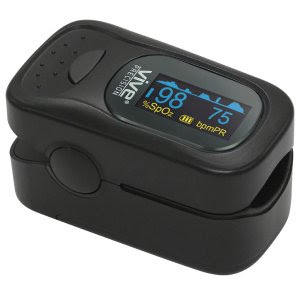Home Oxygen Saturation Monitor: A Review

What is a pulse oximeter?
A pulse oximeter is a device used to indirectly measure blood oxygen saturation. The body regulates oxygen saturation precisely for a specific balance of oxygen in the blood.
What are normal oxygen saturation levels?
Normal pulse oximeter readings for oxygen saturation range between 95 – 100 percent. A saturation level between 90 – 95 percent would be considered low, but does not necessarily indicate a health concern. A blood oxygen saturation level below 90 percent is considered low.
Who should monitor oxygen levels at home?
A pulse oximeter provides safe, non-invasive monitoring of the cardiorespiratory condition for patients who warrant monitoring, such as patients with chronic obstructive pulmonary disease.
Pulse oximetry is also used in high altitudes, such as mountaineering as a red flag for impending altitude sickness and pilots who can experience hypoxia at high altitudes.
Oxygen saturation can be comprised in children with asthma or wheezing and may warrant home monitoring. Pulse oximetry has also been used to determine appropriate treatment methods for individuals with venus leg ulcers and diabetics with vascular disease progression.
Discuss with your doctor to determine if monitoring home oxygen levels would be beneficial for your situation.
What should you look for when selecting a home pulse oximeter?
There are numerous pulse oximeters available. When selecting a device check on these factors:
- Accuracy – Is an accuracy claim backed by evidence, studies, and/or published papers?
- Finger size – Will the device work on all finger sizes or do you need to purchase a specific size oximeter?
- Durability/longevity – How long will the device last?
- Customer service – If you need help, can you reach support easily to get questions answered?
- Target patient – Does the oximeter work on a variety of patients? Those with low circulation? Dark skin tones?
- Environmentally friendly – Does the oximeter contain any hazardous material, such as lead?
Vive Precision Pulse Oximeter
Vive Health produces and markets the Vive Precision Pulse Oximeter. They gifted me one of their pulse oximeters with a request I review the device and provide feedback.
The Vive Precision Pulse Oximeter is a lightweight, portable device for measuring both blood oxygen saturation (SpO2) and pulse rate. It comes with a carrying case and lanyard. To use the device, you simply place your finger inside an antimicrobial vinyl sensor and the measurements are almost instantly displayed on an LCD screen.
You can set the device to have an alarm sound if an irregular heartbeat is detected. This non-toxic silicon device also preserves battery life by automatically powering off after 8 seconds without a signal and it is easy to clean with rubbing alcohol on the rubber padding.
For an accurate reading your fingernail surface must be facing upward when inserted into the pulse oximeter and your finger/body should remain still while taking the measurement. Testing to ensure device accuracy was completed in-house at the product factory.
It’s important to note the Vive Precision Pulse Oximeter is intended more for recreational use, such as sports and aviation. It is not intended for medical use.
As an aside: This is the second Vive Health device I’ve reviewed, the first being the Vive Precision Blood Pressure Monitor. If these two are indicators for the rest of their product line, I appreciate the simplicity of packaging and contents. Very straight-forward to unpack and immediately use, without a ton of “extras” to sort through.
All the best,
Lisa Nelson RD



